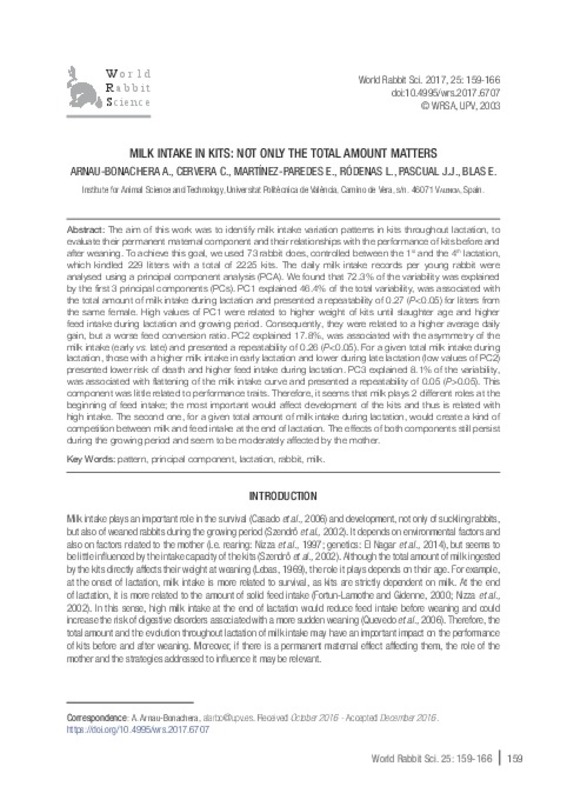JavaScript is disabled for your browser. Some features of this site may not work without it.
Buscar en RiuNet
Listar
Mi cuenta
Estadísticas
Ayuda RiuNet
Admin. UPV
Milk intake in kits: not only the total amount matters
Mostrar el registro sencillo del ítem
Ficheros en el ítem
| dc.contributor.author | Bonachera, Alberto Arnau
|
es_ES |
| dc.contributor.author | Cervera, C.
|
es_ES |
| dc.contributor.author | Martínez-Paredes, E.
|
es_ES |
| dc.contributor.author | Ródenas, L.
|
es_ES |
| dc.contributor.author | Pascual, J. J.
|
es_ES |
| dc.contributor.author | Blas, E.
|
es_ES |
| dc.date.accessioned | 2017-07-10T09:50:02Z | |
| dc.date.available | 2017-07-10T09:50:02Z | |
| dc.date.issued | 2017-06-28 | |
| dc.identifier.issn | 1257-5011 | |
| dc.identifier.uri | http://hdl.handle.net/10251/84827 | |
| dc.description.abstract | [EN] The aim of this work was to identify milk intake variation patterns in kits throughout lactation, to evaluate their permanent maternal component and their relationships with the performance of kits before and after weaning. To achieve this goal, we used 73 rabbit does, controlled between the 1st and the 4th lactation, which kindled 229 litters with a total of 2225 kits. The daily milk intake records per young rabbit were analysed using a principal component analysis (PCA). We found that 72.3% of the variability was explained by the first 3 principal components (PCs). PC1 explained 46.4% of the total variability, was associated with the total amount of milk intake during lactation and presented a repeatability of 0.27 (P<0.05) for litters from the same female. High values of PC1 were related to higher weight of kits until slaughter age and higher feed intake during lactation and growing period. Consequently, they were related to a higher average daily gain, but a worse feed conversion ratio. PC2 explained 17.8%, was associated with the asymmetry of the milk intake (early vs. late) and presented a repeatability of 0.26 (P<0.05). For a given total milk intake during lactation, those with a higher milk intake in early lactation and lower during late lactation (low values of PC2) presented lower risk of death and higher feed intake during lactation. PC3 explained 8.1% of the variability, was associated with flattening of the milk intake curve and presented a repeatability of 0.05 (P>0.05). This component was little related to performance traits. Therefore, it seems that milk plays 2 different roles at the beginning of feed intake; the most important would affect development of the kits and thus is related with high intake. The second one, for a given total amount of milk intake during lactation, would create a kind of competition between milk and feed intake at the end of lactation. The effects of both components still persist during the growing period and seem to be moderately affected by the mother. | es_ES |
| dc.description.sponsorship | This study was supported by the Interministerial Commission for Science and Technology (CICYT) of the Spanish Government (AGL2014-53405-C2-1-P). The authors thank Juan Carlos Moreno for his technical support. Grant for Alberto Arnau from the Ministry of Economy and Finance (BES-2012-052345) is also gratefully acknowledged. | |
| dc.language | Inglés | es_ES |
| dc.publisher | Universitat Politècnica de València | |
| dc.relation.ispartof | World Rabbit Science | |
| dc.rights | Reserva de todos los derechos | es_ES |
| dc.subject | Pattern | es_ES |
| dc.subject | Principal component | es_ES |
| dc.subject | Lactation | es_ES |
| dc.subject | Rabbit | es_ES |
| dc.subject | Milk | es_ES |
| dc.title | Milk intake in kits: not only the total amount matters | es_ES |
| dc.type | Artículo | es_ES |
| dc.date.updated | 2017-07-10T07:30:09Z | |
| dc.identifier.doi | 10.4995/wrs.2017.6707 | |
| dc.relation.projectID | info:eu-repo/grantAgreement/MINECO//AGL2014-53405-C2-1-P/ES/MEJORA GENETICA DEL CONEJO DE CARNE:RESPUESTA A LA SELECCION Y SU EFECTO SOBRE LA REPRODUCCION, ALIMENTACION Y SALUD UTILIZANDO UNA POBLACION CONTROL CRIOCONSERVADA/ | es_ES |
| dc.relation.projectID | info:eu-repo/grantAgreement/MINECO//BES-2012-052345/ES/BES-2012-052345/ | |
| dc.rights.accessRights | Abierto | es_ES |
| dc.description.bibliographicCitation | Bonachera, AA.; Cervera, C.; Martínez-Paredes, E.; Ródenas, L.; Pascual, JJ.; Blas, E. (2017). Milk intake in kits: not only the total amount matters. World Rabbit Science. 25(2):159-166. https://doi.org/10.4995/wrs.2017.6707 | es_ES |
| dc.description.accrualMethod | SWORD | es_ES |
| dc.relation.publisherversion | https://doi.org/10.4995/wrs.2017.6707 | es_ES |
| dc.description.upvformatpinicio | 159 | es_ES |
| dc.description.upvformatpfin | 166 | es_ES |
| dc.description.volume | 25 | |
| dc.description.issue | 2 | |
| dc.identifier.eissn | 1989-8886 | |
| dc.contributor.funder | Comisión Interministerial de Ciencia y Tecnología | |
| dc.contributor.funder | Ministerio de Economía y Competitividad |








